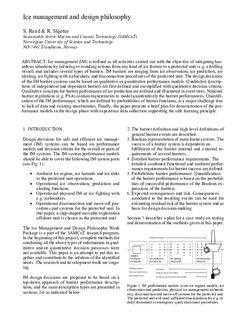| dc.contributor.author | Ruud, Stian Knud | |
| dc.contributor.author | Skjetne, Roger | |
| dc.date.accessioned | 2019-01-30T12:19:23Z | |
| dc.date.available | 2019-01-30T12:19:23Z | |
| dc.date.created | 2018-11-02T14:09:30Z | |
| dc.date.issued | 2018 | |
| dc.identifier.isbn | 978-1-138-54187-0 | |
| dc.identifier.uri | http://hdl.handle.net/11250/2583098 | |
| dc.description.abstract | Ice management (IM) is defined as all activities carried out with the objective of mitigating hazardous situations by reducing or avoiding actions from any kind of ice feature to a protected unit (e.g. a drilling vessel) and includes several types of barriers. IM barriers are ranging from ice observation, ice prediction, ice alerting, ice fighting with icebreakers, and disconnection procedures of the protected unit. The design decisions of the IM barrier systems can be based on qualitative or quantitative performance models. Qualitative descriptions of independent and dependent barriers are first defined and exemplified with qualitative decision criteria. Quali-tative concepts for barrier performance of ice prediction are defined and illustrated in event trees. National barrier regulations (e.g. PSA) contain requirements to model quantitatively the barrier performances. Quantification of the IM performance, which are defined by probabilities of barrier functions, is a major challenge due to lack of data and existing uncertainties. Finally, the paper presents a brief plan for demonstration of the performance models in the design phase with experience data collection supporting the safe learning principle. | nb_NO |
| dc.language.iso | eng | nb_NO |
| dc.publisher | Taylor & Francis | nb_NO |
| dc.relation.ispartof | Marine Design XIII(2018) | |
| dc.relation.uri | https://www.ntnu.edu/samcot | |
| dc.subject | Arktisk teknologi | nb_NO |
| dc.subject | Arctic Technology | nb_NO |
| dc.subject | Isforvaltning | nb_NO |
| dc.subject | Ice Management | nb_NO |
| dc.subject | Risikostyring | nb_NO |
| dc.subject | Risk management | nb_NO |
| dc.title | Ice management and design philosophy | nb_NO |
| dc.title.alternative | Ice management and design philosophy | nb_NO |
| dc.type | Chapter | nb_NO |
| dc.description.version | acceptedVersion | nb_NO |
| dc.subject.nsi | VDP::Offshoreteknologi: 581 | nb_NO |
| dc.subject.nsi | VDP::Offshore technology: 581 | nb_NO |
| dc.source.pagenumber | 819-830 | nb_NO |
| dc.identifier.doi | 10.1201/9780429440519 | |
| dc.identifier.cristin | 1626434 | |
| dc.relation.project | Norges forskningsråd: 223254 | nb_NO |
| dc.relation.project | Norges forskningsråd: 203471 | nb_NO |
| dc.description.localcode | Locked until 4.6.2019 due to copyright restrictions. This is an Accepted Manuscript of a book chapter published by Routledge/CRC Press in [Marine Design XIII(2018)] on [4 June 2018], available online: https://www.taylorfrancis.com/books/9780429440519/chapters/10.1201/9780429440519-20 | nb_NO |
| cristin.unitcode | 194,64,91,0 | |
| cristin.unitcode | 194,64,20,0 | |
| cristin.unitname | Institutt for bygg- og miljøteknikk | |
| cristin.unitname | Institutt for marin teknikk | |
| cristin.ispublished | true | |
| cristin.fulltext | preprint | |
| cristin.qualitycode | 1 | |
